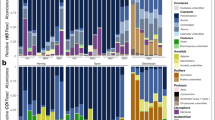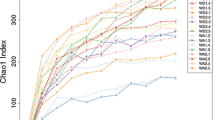Abstract
Copepods are a key trophic link between primary producers and predatory animals at higher trophic levels in the marine ecosystem. Knowledge of the in situ composition of the copepod diet is critical for the accurate evaluation of trophic relationships and energy transfer in marine food webs. In this study, we applied a PCR-based cloning technique developed previously to investigate the in situ diet of Calanus sinicus, an ecologically important largesized calanoid copepod that dominates in the shelf waters around China, Japan and Korea. Analyses of the 18S rDNA sequences obtained from the copepod diet revealed the diverse food composition of C. sinicus from two stations (Y19 in the South Yellow Sea and B49 in the Bohai Sea). A total of 43 operational taxonomic units (OTUs) were detected, which belonged to 13 diverse lineages: Bacillariophyta, Dinoflagellata, Dictyochophyceae, Chrysophyta, Katablepharidophyta, Pelagophyceae, Apusozoa, Hydrozoa, Ctenophora, Echinodermata, Tunicata, Chaetognatha and marine fungi. The results indicate that during an algae bloom, C. sinicus can graze on the bloom causative species. When the abundance of phytoplankton in ambient water is relatively low, C. sinicus can choose eggs, larvae, or organic particles/detritus of various metazoans, especially hydrozoans and ctenophores, as alternative food sources. Our result suggests that C. sinicus is an omnivorous species, and its prey choice may depend on the food availability in the ambient waters.
Similar content being viewed by others
References
Altschul S F, Madden T L, Schäffer A A, et al. 1997. Gapped BLAST and PSI-BLAST: a new generation of protein database search programs. Nucleic Acids Research, 25(17): 3389–3402
Ban S, Burns C, Castel J, et al. 1997. The paradox of diatom-copepod interactions. Marine Ecology Progress Series, 157: 287–293
Barofsky A, Simonelli P, Vidoudez C, et al. 2010. Growth phase of the diatom Skeletonema marinoi influences the metabolic profile of the cells and the selective feeding of the copepod Calanus spp. Journal of Plankton Research, 32(3): 263–272
Boling W B, Sinclair G A, Wawrik B. 2012. Identification of calanoid copepod prey species via molecular detection of carbon fixation genes. Marine Biology, 159(5): 1165–1171
Bråte J, Logares R, Berney C, et al. 2010. Freshwater Perkinsea and marine-freshwater colonizations revealed by pyrosequencing and phylogeny of environmental rDNA. The ISME Journal, 4(9): 1144–1153
Buffan-Dubau E, de Wit R, Castel J. 1996. Feeding selectivity of the harpacticoid copepod Canuella perplexa in benthic muddy environments demonstrated by HPLC analyses of chlorin and carotenoid pigments. Marine Ecology Progress Series, 137(1–3): 71–82
Calbet A. 2008. The trophic roles of microzooplankton in marine systems. ICES Journal of Marine Science, 65(3): 325–331
Calbet A, Vaqué D, Felipe J, et al. 2003. Relative grazing impact of microzooplankton and mesozooplankton on a bloom of the toxic dinoflagellate Alexandrium minutum. Marine Ecology Progress Series, 259: 303–309
Chen Qingchao. 1964. A study of the breeding periods, variation in sex ratio and in size of Calanus sinicus Brodsky. Oceanologia et Limnologia Sinica (in Chinese), 6(3): 272–288
Chen M R, Kâ S, Hwang J S. 2010. Diet of the copepod Calanus sinicus Brodsky, 1962 (Copepoda, Calanoida, Calanidae) in northern coastal waters of Taiwan during the northeast monsoon period. Crustaceana, 83(7): 851–864
Du Mingmin, Liu Zhensheng, Wang Chunsheng, et al. 2013. The seasonal variation and community structure of zooplankton in China sea. Acta Ecologica Sinica (in Chinese), 33(17): 5407–5418
Guo Zhiling, Liu Sheng, Hu Simin, et al. 2012. Prevalent ciliate symbiosis on copepods: high genetic diversity and wide distribution detected using small subunit ribosomal RNA gene. PLoS One, 7(9): e44847
Hu Simin, Guo Zhiling, Li Tao, et al. 2014. Detecting in situ copepod diet diversity using molecular technique: development of a copepod/symbiotic ciliate-excluding eukaryote-inclusive PCR protocol. PLoS One, 9(7): e103528
Hu Simin, Guo Zhiling, Li Tao, et al. 2015. Molecular analysis of in situ diets of coral reef copepods: evidence of terrestrial plant detritus as a food source in Sanya Bay, China. Journal of Plankton Research, 37(2): 363–371
Huang Yousong, Xu Donghui, Chen Hongju, et al. 2014. PCR-based in situ dietary analysis of Calanus sinicus Brodsky in Yellow River estuary and adjacent waters. Periodical of Ocean University of China (in Chinese), 44(3): 83–91
Hulsemann K. 1994. Calanus sinicus Brodsky and C. jashmovi, nom. nov. (Copepoda: Calanoida) of the North-western Pacific Ocean: a comparison, with notes on the integumental pore pattern in Calanus s. str. Invertebrate Taxonomy, 8(6): 1461–1482
Huo Yuanzi, Wang Shiwei, Sun Song, et al. 2008. Feeding and egg production of the planktonic copepod Calanus sinicus in spring and autumn in the Yellow Sea, China. Journal of Plankton Research, 30(6): 723–734
Ianora A, Miralto A, Poulet S A, et al. 2004. Aldehyde suppression of copepod recruitment in blooms of a ubiquitous planktonic diatom. Nature, 429(6990): 403–407
Irigoien X, Meyer B, Harris R, et al. 2004. Derek Harbour Using HPLC pigment analysis to investigate phytoplankton taxonomy: the importance of knowing your species. Helgoland Marine Research, 58(2): 77–82
Jones R H, Flynn K J. 2005. Nutritional status and diet composition affect the value of diatoms as copepod prey. Science, 307(5714): 1457–1459
King R A, Read D S, Traugott M, et al. 2008. Molecular analysis of predation: a review of best practice for DNA-based approaches. Molecular Ecology, 17(4): 947–963
Larkin M A, Blackshields G, Brown N P, et al. 2007. Clustal W and Clustal X version 2.0. Bioinformatics, 23(21): 2947–2948
Li Shaojing. 1964. Preliminary studies on the food and feeding habits of some marine planktonic copepods in Amoy waters. Journal of Xiamen University (Natural Science) (in Chinese), 11(3): 93–109
Lin Senjie, Zhang Huan, Hou Yubo, et al. 2009. High-level diversity of dinoflagellates in the natural environment, revealed by assessment of mitochondrial cox1 and cob genes for dinoflagellate DNA barcoding. Applied and Environmental Microbiology, 75(5): 1279–1290
Liu Mengtan, Li Chaolun, Sun Song. 2011. Seasonal variation in fatty acid composition of seston and the copepod Calanus sinicus (Brodsky, 1962) in Jiaozhou Bay and its trophic implications. Chinese Journal of Oceanology and Limnology, 29(6): 1164–1173
López-García P, Rodríguez-Valera F, Pedrós-Alió C, et al. 2001. Unexpected diversity of small eukaryotes in deep-sea Antarctic plankton. Nature, 409(6820): 603–607
Maloy A P, Culloty S C, Slater J W. 2013. Dietary analysis of small planktonic consumers: a case study with marine bivalve larvae. Journal of Plankton Research, 35(4): 866–876
Moon-van der Staay S Y, De Wachter R, Vaulot D. 2001. Oceanic 18S rDNA sequences from picoplankton reveal unsuspected eukaryotic diversity. Nature, 409(6820): 607–610
Motwani N H, Gorokhova E. 2013. Mesozooplankton grazing on picocyanobacteria in the Baltic Sea as inferred from molecular diet analysis. PLoS One, 8(11): e79230
Nejstgaard J C, Frischer M E, Raule C L, et al. 2003. Molecular detection of algal prey in copepod guts and fecal pellets. Limnology and Oceanography: Methods, 1(1): 29–38
Nejstgaard J C, Frischer M E, Simonelli P, et al. 2008. Quantitative PCR to estimate copepod feeding. Marine Biology, 153(4): 565–577
Pompanon F, Deagle B E, Symondson W O C, et al. 2012. Who is eating what: diet assessment using next generation sequencing. Molecular Ecology, 21(8): 1931–1950
Richards T A, Jones M D M, Leonard G, et al. 2012. Marine fungi: their ecology and molecular diversity. Annual Review of Marine Science, 4(1): 495–522
Riemann L, Alfredsson H, Hansen M M, et al. 2010. Qualitative assessment of the diet of European eel larvae in the Sargasso Sea resolved by DNA barcoding. Biology Letters, 6(6): 819–822
Saiz E, Calbet A. 2011. Copepod feeding in the ocean: scaling patterns, composition of their diet and the bias of estimates due to microzooplankton grazing during incubations. Hydrobiologia, 666(1): 181–196
Sautour B, Artigas L F, Delmas D, et al. 2000. Grazing impact of micro- and mesozooplankton during a spring situation in coastal waters off the Gironde estuary. Journal of Plankton Research, 22(3): 531–552.
Schloss P D, Westcott S L, Ryabin T, et al. 2009. Introducing mothur: open-source, platform-independent, community-supported software for describing and comparing microbial communities. Applied and Environmental Microbiology, 75(23): 7537–7541
Schmidt K, Atkinson A, Stübing D, et al. 2003. Trophic relationships among Southern Ocean copepods and krill: Some uses and limitations of a stable isotope approach. Limnology and Oceanography, 48(1): 277–289
Schnetzer A, Steinberg D. 2002. Natural diets of vertically migrating zooplankton in the Sargasso Sea. Marine Biology, 141(1): 89–99
Sieburth J M, Johnson P W, Hargraves P E. 1988. Ultrastructure and ecology of Aureococcus anophageferens gen. et sp. nov. (Chrysophyceae): the dominant picoplankter during a bloom in Narragansett Bay, Rhode Island, summer 1985. Journal of Phycology, 24(3): 416–425
Tamura K, Peterson D, Peterson N, et al. 2011. MEGA5: molecular evolutionary genetics analysis using maximum likelihood, evolutionary distance, and maximum parsimony methods. Molecular Biology and Evolution, 28(10): 2731–2739
Turner J T. 2004. The importance of small planktonic copepods and their roles in pelagic marine food webs. Zoological Studies, 43(2): 255–266
Turner J T. 2015. Zooplankton fecal pellets, marine snow, phytodetritus and the ocean’s biological pump. Progress in Oceanography, 130: 205–248
Utermöhl H. 1958. Zur vervollkommnung der quantitativen phytoplankton- methodik. Mitteilingen der Internationalen Vereinigung fur Theoretische und Angewandte Limnologie, 9: 1–38
Uye S. 2000. Why does Calanus sinicus prosper in the shelf ecosystem of the Northwest Pacific Ocean?. ICES Journal of Marine Science, 57(6): 1850–1855
Verschoor A M, Boonstra H, Meijer T. 2005. Application of stable isotope tracers to studies of zooplankton feeding, using the rotifer Brachionus calyciflorus as an example. In: Herzig A, Gulati R, Jersabek C, et al., eds. Rotifera X. Netherlands: Springer, 535–549
Yang Jiming. 1997. Primary study on the feeding of the Bohai Sea Calanus sinicus. Oceanologia et Limnologia Sinica (in Chinese), 28(4): 376–382
Yi Xiaoyan, Zhang Huan, Liu Guangxing. 2014. Primers to block the amplification of symbiotic apostome ciliate 18S rRNA gene in a PCR-based copepod diet study. Chinese Journal of Oceanology and Limnology, 32(3): 515–521
Zhang Huan, Bhattacharya D, Lin Senjie. 2005. Phylogeny of dinoflagellates based on mitochondrial cytochrome b and nuclear small subunit rDNA sequence comparisons. Journal of Phycology, 41(2): 411–420
Zhang Guangtao, Li Chaolun, Sun Song, et al. 2006. Feeding habits of Calanus sinicus (Crustacea: Copepoda) during spring and autumn in the Bohai Sea studied with the herbivore index. Scientia Marina, 70(3): 381–388
Zhang Huan, Lin Senjie. 2002. Detection and quantification of Pfiesteria piscicida by using the mitochondrial cytochrome b gene. Applied and Environmental Microbiology, 68(2): 989–994
Zhang Huan, Lin Senjie. 2005. Development of a cob-18S rRNA gene real-time PCR assay for quantifying Pfiesteria shumwayae in the natural environment. Applied and Environmental Microbiology, 71(11): 7053–7063
Zhang Qingchun, Qiu Limei, Yu Rencheng, et al. 2012. Emergence of brown tides caused by Aureococcus anophagefferens Hargraves et Sieburth in China. Harmful Algae, 19: 117–124
Zöllner E, Hoppe H G, Sommer U, et al. 2009. Effect of zooplanktonmediated trophic cascades on marine microbial food web components (bacteria, nanoflagellates, ciliates). Limnology and Oceanography, 54(1): 262–275
Acknowledgements
The authors thank Fang Jing and Li Zishang and the crew of R/V Dongfanghong II for collecting the field samples. The authors also thank Zhang Yushan Minnie from University of Connecticut helped improve the English writing of the manuscript.
Author information
Authors and Affiliations
Corresponding author
Additional information
Foundation item: The National Natural Science Foundation of China under contract Nos 31372509, 41076085 and 41328009.
These authors contributed equally to this work.
Rights and permissions
About this article
Cite this article
Yi, X., Huang, Y., Zhuang, Y. et al. In situ diet of the copepod Calanus sinicus in coastal waters of the South Yellow Sea and the Bohai Sea. Acta Oceanol. Sin. 36, 68–79 (2017). https://doi.org/10.1007/s13131-017-0974-6
Received:
Accepted:
Published:
Issue Date:
DOI: https://doi.org/10.1007/s13131-017-0974-6




